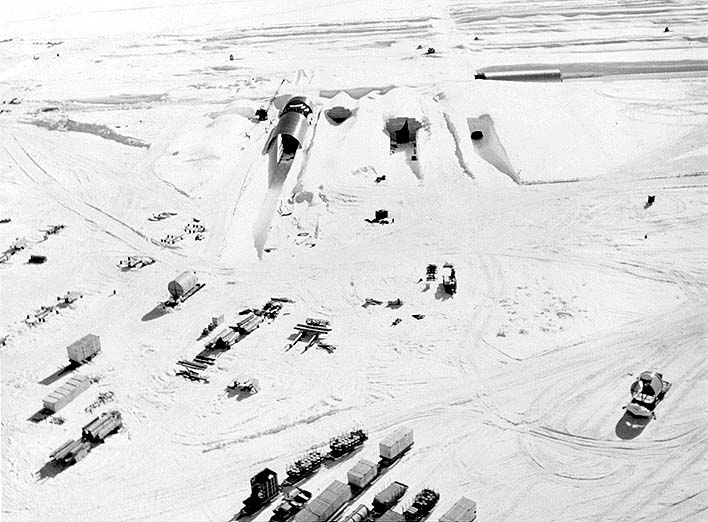
According to the documents published by the Kingdom of
Denmark in 1997, the U.S. Army’s “Iceworm” missile network was
outlined in a 1960 Army report titled “Strategic Value of the Greenland
Icecap”. If fully implemented, the project would cover an area of 52,000
square miles (130,000 km2), roughly three times the size of Denmark. The launch
complex floors would be 28 feet (8.5 m) below the surface, with the missile
launchers even deeper, and clusters of missile launch centers would be spaced 4
miles (6.4 km) apart. New tunnels were to be dug every year, so that after five
years there would be thousands of firing positions, among which the several
hundred missiles could be rotated. The Army intended to deploy a shortened,
two-stage version of the U.S. Air Force’s Minuteman missile, a variant the Army
proposed calling the Iceman.
Project Iceworm was a top-secret United States Army program of the Cold War, which aimed to build a network of mobile nuclear missile launch sites under the Greenland ice sheet. The ultimate objective of placing medium-range missiles under the ice — close enough to strike targets within the Soviet Union — was kept secret from the Government of Denmark. To study the feasibility of working under the ice, a highly publicized “cover” project, known as Camp Century, was launched in 1960. Unstable ice conditions within the ice sheet caused the project to be canceled in 1966.
One of the most well-known US military bases in the Arctic
is Thule Air Base, in Greenland’s frigid northwest. Less well-known is the
now-defunct Camp Century. Just 150 miles from Thule, the area surrounding Camp Century is bitterly
cold. Nighttime temperatures dip to -70°F and wind whips ice and snow through
the air at 125 miles per hour.
Camp Century was opened in 1960 rather openly— the US Army
released a short documentary film outlining the new construction techniques
used to build the camp. Publicly at least, the camp was supposed to be used for
conducting scientific research in the Arctic.
In reality, Camp Century was cover for a top-secret weapons
project. The Danish government was opposed to housing nuclear weapons on their
soil, and was thus not informed about Camp Century’s true purpose.
At Camp Century, engineers developed and improved
subterranean Arctic building techniques. Modified tractors cut deep trenches
nearly 30 feet into the ice. These trenches were then covered with steel
semicylinders and topped with snow and ice that froze them firmly into place,
providing shelter for the small underground city.
Transporting or airdropping diesel to fuel power generators
would have been prohibitively expensive, and impossible during extreme weather
conditions. The solution was to install a portable nuclear reactor that
addressed all of Century’s electricity needs.
Heating Up:
Building upon lessons learned from Camp Century, Project
Iceworm was to be built on a massive scale. Iceworm would have been the world’s
largest ICBM launch site— over 52,000 miles of tunnels cut deep into the
Greenland ice sheet. Iceworm’s footprint would cover an about the size of the
state of Indiana, and a whopping three times the size of the host country,
Denmark.
600 modified “Iceman” Minuteman missiles would be
transported underground on large road-sized tunnels via railcar to launching
sites cut even deeper into the ice. The Iceman missiles would be constantly
shifting to other sites to keep their exact locations a secret. The
subterranean placement and a mandatory 4-mile distance between launch sites
would offer a degree of protection and increase survivability in the event of
an attack by the Soviet Union.
Greenland’s proximity to the Soviet Union would have given
American Minuteman missiles an enormous strategic advantage. Greenland is much
closer to Russia than the continental United States, and the Iceman ICBMs would
have been able to strike almost any target within the Soviet Union at a
moment’s notice. The sheer size of the planned Iceworm complex and the
missile’s relatively wide distribution would help to ensure the United States’
second-strike capability and to strengthen the land-based leg of the US nuclear
triad.
Doomed to Die:
Alas, Project Iceworm was not practically feasible. Initial
surveys had indicated that the Greenland ice sheet was rigid and ideal for
tunneling. Later data gathered during the Camp Century experiment showed that
the ice sheet was actually very elastic. Tunnels would have to be constantly
maintained and be in danger of collapse every few years.
The extreme weather conditions also made steel building
materials brittle and prone to cracking. Communications problems between the
Pentagon and Camp Century were also an issue: sending or receiving messages
during extreme weather events was problematic.
Ticking Time Bomb
In the 1960s global warming was not a part of Pentagon
strategic thinking. After shuttering Camp Century in 1967, The Army Corp of
Engineers left behind thousands of gallons of radioactive water used to cool
the portable reactor, and an unknown amount of sewage to be forever entombed in
Greenland’s ice shelf.
In 1997, the Kingdom of Denmark conducted an inquiry into
Camp Century, revealing the deceptive nature of the camp and the remaining
hazardous waste enclosed in the ice.
Estimates from the scientific community predict that by 2090, the ice under Camp Century will begin to melt, releasing radioactive and human waste into the ocean. It remains to be decided if either the United States or Denmark, or perhaps even the now-autonomous Greenland will be responsible for cleanup.